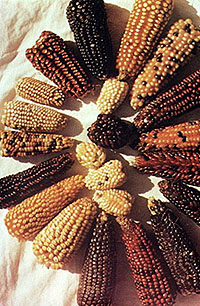Domestication
- page 4 -
Maize, the Staple Crop of the Americas
 Maize, or what Americans tend to call "corn," was first domesticated in Meso-America several thousand years ago. It became the main food crop of many cultures from eastern North America to Chile in South America. So central was maize-growing in the Americas that the Mayas, for example, regarded themselves as having been created by the gods out of maize. Maize was highly adaptable, and selective breeding over centuries created subspecies able to flourish in such diverse climates as New England, the arid South West of the U.S., the wet tropical lowlands of Mexico and Guatemala, and mountain plateaus 9,000 feet high in the central Andes of South America.
Maize, or what Americans tend to call "corn," was first domesticated in Meso-America several thousand years ago. It became the main food crop of many cultures from eastern North America to Chile in South America. So central was maize-growing in the Americas that the Mayas, for example, regarded themselves as having been created by the gods out of maize. Maize was highly adaptable, and selective breeding over centuries created subspecies able to flourish in such diverse climates as New England, the arid South West of the U.S., the wet tropical lowlands of Mexico and Guatemala, and mountain plateaus 9,000 feet high in the central Andes of South America.
Maize has many advantages over wheat or barley. Seed-bed preparation can be accomplished with a digging stick. Harvest is easier and the standing crop is less easily spoiled by moisture or wind. Most importantly, the return on seeds planted was as high as 45 to 1 at a very early date. In contrast, early wheat farmers may have realized only a 6-1 return on seeds planted.
Maize has excellent nutritional value and, eaten together with squash and beans, the other staples of early American agriculture, provides all the amino acids necessary for human life.
 Maize, or what Americans tend to call "corn," was first domesticated in Meso-America several thousand years ago. It became the main food crop of many cultures from eastern North America to Chile in South America. So central was maize-growing in the Americas that the Mayas, for example, regarded themselves as having been created by the gods out of maize. Maize was highly adaptable, and selective breeding over centuries created subspecies able to flourish in such diverse climates as New England, the arid South West of the U.S., the wet tropical lowlands of Mexico and Guatemala, and mountain plateaus 9,000 feet high in the central Andes of South America.
Maize, or what Americans tend to call "corn," was first domesticated in Meso-America several thousand years ago. It became the main food crop of many cultures from eastern North America to Chile in South America. So central was maize-growing in the Americas that the Mayas, for example, regarded themselves as having been created by the gods out of maize. Maize was highly adaptable, and selective breeding over centuries created subspecies able to flourish in such diverse climates as New England, the arid South West of the U.S., the wet tropical lowlands of Mexico and Guatemala, and mountain plateaus 9,000 feet high in the central Andes of South America.